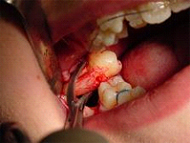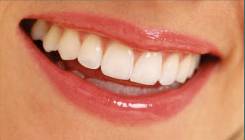 Surgical extraction of an impacted molar..
Surgical extraction of an impacted molar..
A dental extraction (also referred to as exodontia) is the removal of a tooth. Extractions are performed for a wide variety of reasons, including dental caries that has destroyed enough tooth structure to prevent restoration. Extractions of impacted or problematic wisdom teeth are routinely performed, as are extractions of some permanent teeth to make space for orthodontic treatment.
History
Historically, dental extractions have been used to treat a variety of illnesses, as well as a method of torture to obtain forced confessions. Before the discovery of antibiotics, chronic tooth infections were often linked to a variety of health problems, and therefore removal of a diseased tooth was a common treatment for various medical conditions. Instruments used for dental extractions date back several centuries. As dental extractions can vary tremendously in difficulty, depending on the patient and the tooth, a wide variety of instruments exist to address specific situations.
Reasons for tooth extraction
The most common reason for extraction is tooth damage due to breakage or decay. There are additional reasons for tooth extraction:
- Severe tooth decay or infection. Despite the reduction in worldwide prevalence of dental caries, still it is the most common reason for extraction of (non-third molar) teeth with up to two thirds of extractions.
- Extra teeth which are blocking other teeth from coming in.
- Severe gum disease which may affect the supporting tissues and bone structures of teeth.
- In preparation for orthodontic treatment.
- Teeth in the fracture line.
- Fractured teeth.
- Insufficient space for wisdom teeth (impacted third molars). Although many dentists remove asymptomatic impacted third molars, American as well as British Health Authorities recommended against this routine procedure, unless there are evidences for disease in the impacted tooth or the near environment The American Public Health Association, for example, adopted a policy, Opposition to Prophylactic Removal of Third Molars (Wisdom Teeth) because of the large number of injuries resulting from unnecessary extractions
- Receiving radiation to the head and neck may require extraction of teeth in the field of radiation.
Types of extraction
Extractions are often categorized as "simple" or "surgical".
Simple extractions are performed on teeth that are visible in the mouth, usually under local anaesthetic, and require only the use of instruments to elevate and/or grasp the visible portion of the tooth. Typically, when teeth are removed with forceps, slow, steady pressure is applied with controlled force.
Surgical extractions involve the removal of teeth that cannot be easily accessed, either because they have broken under the gum line or because they have not erupted fully. Surgical extractions almost always require an incision. In a surgical extraction the doctor may elevate the soft tissues covering the tooth and bone and may also remove some of the overlying and/or surrounding bony tissue with a drill or osteotome. Frequently, the tooth may be split into multiple pieces to facilitate its removal.
Post-extraction healing
Following extraction of a tooth, a blood clot forms in the socket, usually within an hour. Bleeding is common in this first hour, but its likelihood decreases quickly as time passes, and is unusual after 24 hours. The raw open wound overlying the dental socket takes about 1 week to heal. Thereafter, the socket will gradually fill in with soft gum tissue over a period of about one to two months. Final closure of the socket with bony remodeling can take six months or more.
Complications
- Infection: although rare, it does occur on occasion. Patient must follow the post operative instructions to avoid infection.
- Prolonged bleeding: The dentist has a variety of means at their disposal to address bleeding; however, it is important to note that small amounts of blood mixed in the saliva after extractions are normal, even up to 72 hours after extraction. Usually, however, bleeding will almost completely stop within eight hours of the surgery, with only minuscule amounts of blood mixed with saliva coming from the wound. A gauze compress will significantly reduce bleeding over a period of a few hours. The patient must avoid rinsing with water or spitting frequently especially for the first 24hours of surgery.
- Swelling: Often dictated by the amount of surgery performed to extract a tooth (e.g. surgical insult to the tissues both hard and soft surrounding a tooth). Generally, when a surgical flap must be elevated , minor to moderate swelling will occur. Similarly, when bone must be removed using a drill, more swelling is likely to occur.
- Sinus exposure and oral-antral communication: This can occur when extracting upper molars. The maxillary sinus sits right above the roots of maxillary molars and premolars. This bone can range from thick to thin from tooth to tooth from patient to patient. In some cases it is absent and the root is in fact in the sinus. At other times, this bone may be removed with the tooth, or may be perforated during surgical extractions. The doctor typically mentions this risk to patients, based on evaluation of radiographs showing the relationship of the tooth to the sinus.
- Nerve injury: This is primarily an issue with extraction of third molars, but can occur with the extraction of any tooth should the nerve be close to the surgical site. Two nerves are typically of concern, and are found in duplicate (one left and one right): Such injuries are rare and are usually temporary, but depending on the type of injury.
- Dry socket (Alveolar osteitis) is a painful phenomenon that most commonly occurs a few days following the removal of (lower) wisdom teeth. It is commonly believed ] that it occurs because the blood clot within the healing tooth extraction site is disrupted. Inflamed alveolar bone, unprotected and exposed to the oral environment after tooth extraction, can become packed with food and debris. A dry socket typically causes a sharp and sudden increase in pain commencing 2–5 days following the extraction of a mandibular molar, most commonly the third molar. This is often extremely unpleasant for the patient; the only symptom of dry socket is pain, which often radiates up and down the head and neck. A dry socket is not an infection, and is not directly associated with swelling because it occurs entirely within bone — it is a phenomenon of inflammation within the bony lining of an empty tooth socket. Because dry socket is not an infection, the use of antibiotics has no effect on its rate of occurrence. The risk factor for alveolar osteitis can dramatically increase with smoking after an extraction.
- Bone fragment: Particularly when extraction of molars is involved, it is not uncommon for the bones which formerly supported the tooth to shift and in some cases to erupt through the gums, presenting protruding sharp edges which can irritate the tongue and cause discomfort. This is distinguished from a similar phenomena where broken fragments of bone or tooth left over from the extraction can also protrude through the gums. In the latter case, the fragments will usually work their way out on their own. In the former case, the protrusions can either be snipped off by the dentist, or eventually the exposed bone will erode away on its own.











